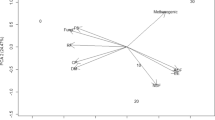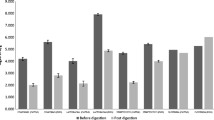Abstract
The occurrence of microfloral components on medicated and non-medicated swine and chicken feed pellets and crumbles, produced in a Manitoba feed mill between June 1991 and October 1992, was determined. Addition of medicates to feeds generally decreased bacterial incidence and increased that of Eurotium spp. fungi. The effect was less pronounced when copper sulphate was added to medicated swine feeds.
Similar content being viewed by others
References
Jacques KA. Molds: the hidden killer in feeds. In: Lyons TP (ed), Biotechnology in the Feed Industry. Alltech Technical Publications, Nicholasville, KY, 1987: 291–303.
Jones F. Consequences of moulds in feeds. Feed International 1987; 8(3): 20–26.
Abramson D, Mills JT, Boycott BR. Mycotoxins and mycoflora in animal feedstuffs in western Canada. Can J Comp Med 1983; 47: 23–26.
Scott PM, Van Walbeek W, Kennedy B, Anyeti D. Mycotoxins (ochratoxin A, citrinin, and sterigmatocystin) and toxigenic fungi in grains and other agricultural products. J Agr Food Cheml 1972; 20: 1103–1108.
Ogundero VW. Fungal flora of poultry feeds. Mycologia 1980; 72: 200–202.
Bauduret P. A mycological and bacteriological survey on feed ingredients and mixed poultry feeds in Reunion Island. Mycopathologia 1990; 109: 157–164.
Moreno MA, Suárez G. Mycoflora of commercial poultry mixed feeds. Poultry Sci 1986; 65: 284–287.
Chang-Yen I, Bidasee K, Rampersad G. Mycoflora and mycotoxin-producing potential of fungi from poultry feeds and feed ingredients in Trinidad. J Sci Food Agric 1992; 60: 283–286.
Scudamore KA, Buckle AE. The occurrence and significance of moulds and mycotoxins in cereals and animal feedstuffs in the United Kingdom. In: Lawson TJ (ed), Stored Products Pest Control. British Crop Protection Council, Thornton Heath, UK, 1987: 33–42.
Blair R. Canadian regulations governing use of growth promoters, drugs in animal feeds updated for 1989. Feedstuffs 1989; 61(28): 14–17 (July 10, 1989).
Mills JT, White NDG. Seasonal occurrence of insects and mites in a Manitoba feed mill. Proc Ent Soc Manitoba 1993; 49: 1–15.
Agriculture Canada. Compendium of medicating ingredient brochures. 6th ed. 1990. Food Production and Inspection Branch, Ottawa.
Martin H. Inorganics. In: Torgeson DC (ed), Fungicides; An Advanced Treatise. Vol II. New York, NY: Academic Press, 1969; 101–117.
Wallace HAH, Sinha RN. Fungi associated with hot spots in farm-stored grain. Can J Plant Sci 1962; 42: 130–141.
Mills JT, Sinha RN, Wallace HAH. Multivariate evaluation of isolation techniques for fungi associated with stored rapeseed. Phytopathology 1978; 68: 1520–1525.
SAS Institute. SAS/STAT User's Guide, Version 6, Fourth Edition, Volume 1, Cary, NC, 1990.
Abarca ML, Bragulat MR, Castellá G, Cabañes FJ. Mycoflora and aflatoxin-producing strains in animal mixed feeds. J Food Prot 1994; 57: 256–258.
Moreau C. Moisissures des aliments dans une ferme d'élevage porcin. Bull Soc Mycol Fr 1978; 94: 359–369.
Bragulat MR, Abarca ML, Castellá G, Cabañes FJ. A mycological survey on mixed poultry feeds and mixed rabbit feeds. J Sci Food Agric 1995; 67: 215–220.
Lovett J, Messer JW, Read Jr. RB. The microflora of Southern Ohio poultry litter 1971; 50: 746–751.
Moharram AM, Abdel-Gawad KM, Megalla SE, Mahmoud A-L. E. Fungal flora of poultry feedstuff ingredients. J Basic Microbiol 1989; 29: 491–499.
Stewart RG, Wyatt RD, Ashmore MD. The effect of various antifungal agents on afloatoxin production and growth characteristics of Aspergillus parasiticus and Aspergillus flavus in liquid medium. Poultry Science 1977; 56: 1630–1635.
Cromwell, GL. Antimicrobial agents. In: Miller ER, Ullrey DE, Lewis AJ (eds), Swine Nutrition. Boston, MA: Butterworth-Heinemann, 1993; 297–314.
Author information
Authors and Affiliations
Additional information
Contribution No. 1662.
Rights and permissions
About this article
Cite this article
Mills, J.T., White, N.D.G. & Woods, S.M. Effect of medicating ingredients and other additives on microflora present on swine and chicken feeds from a Manitoba mill. Mycopathologia 135, 21–27 (1996). https://doi.org/10.1007/BF00436571
Received:
Accepted:
Issue Date:
DOI: https://doi.org/10.1007/BF00436571




